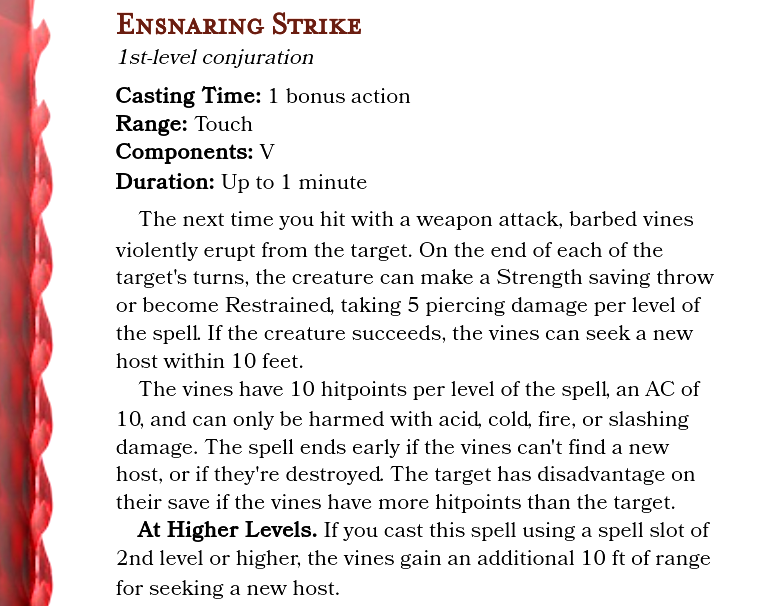Spell Redesign: Ensnaring Strike
Ensnaring strike is probably one of the better ranger spells. The capacity to restrain someone at first level with a single-target strike (accompanying a weapon attack to boot) is obviously attractive. Additionally, it deals a little bit of damage! How charming!
To counterbalance these goodies, ensnaring strike can be removed by another creature. Larger creatures have advantage on their save, and Strength is a pretty common save of creatures to begin with.
Also, the spell requires concentration, for no reason other than being a duration spell. This puts it into direct conflict with hail of thorns (a single-use area attack) and hunter’s mark, turning what would be a fine hunter’s toolkit into a mess of FOMO and pointlessly exclusive choices.
My Version (Better)
This will measure up nicely to my prior hail of thorns redesign. My fixes for this spell were initially quite tame! To be perfectly honest, I could have just removed the concentration requirement and called it a day. In an effort to improve the spell in line with my initial goals (and some recently articulated new principles), I approached this spell with two directives.
Make the spell complex enough to develop an individual strategy around its use.
Make the spell contribute to the sandbox’s incidental effects.
My Version (Even Better)
Let’s use my second pass to explain that earlier principle: contributing to a sandbox’s incidental effects. When we describe the mechanical sandbox in video games, we describe the overall feel and expected moment-to-moment play. Most of the sandbox will feel relatively similar or even identical across large swaths of its individual elements. But there’s a category of small additional elements attached to other mechanics (sometimes called riders) and independent elements (environmental assets like boxes or crates) serving no independent purpose (boxes and crates are not standard equipment). These small additional elements are cumulative in a well designed game, taking what would be an unchanging gameplay loop and producing wildly varied results (with a positive bias) within the game.
Web, entangle, and hypnotic pattern all have relatively similar effects for fairly identical purposes. Ultimately, they lock critters out of the encounter. However, hypnotic pattern and entangle never burn enemies alive, whereas web produces a flammable area of effect! The errant dropped torch or barrel of oil interacts with web differently than the aforementioned spells. These are actually critical to game design, despite being the smallest individual additions to any sandbox. Halo would be infuriatingly boring if all encounters boiled down to poking, shooting, retreating, reloading, repeat ad infinitum.
“But James, isn’t that all encounters in halo?”
Of course not! The process I outlined describes the basic building blocks of encounters in halo. However, the outcomes of Halo are more often determined by things like the positioning or destruction of cover, the weapons you gave to AI companions, the detonation of dropped grenades or fuel cells, accidental kills providing you with use of a vehicle, environmental kills from the errant cargo crate or pallet jack sent flying by a hunter’s charge or tank’s shot. The poke-shoot-reload pattern of play may be Halo’s bread and butter, and a lot of work went into making the feedback and results of this gameplay loop satisfying (the so-called 15s of fun). It nevertheless ultimately pales in comparison to the outcomes and gameplay varierty provided by the sandbox’s incidental riders and independent elements, which allow you to win (and occasionally lose) in entertaining and diverse ways.
Here’s where entangling strike comes into play: the hitpoint conditions of the vine make the spell’s results more precarious. Say a critter gets hit by my new ensnaring strike, followed by a fireball. What’s the outcome?
The vine’s hitpoints were decremented to lower than the target’s, giving it a better chance of escaping, or permitting a nearby ally to destroy the vines outright.
The vine’s hitpoints were completely destroyed, but so was the target; it automatically failed its save vs the fireball on account of restrained.
The target’s hitpoints were decremented to lower than the vine’s, so it has disadvantage on future saving throws.
The vine’s hitpoints were decremented lower than the target’s by this fireball, giving it a better chance to escape. This escape allows the vines to target a new creature who was hurt more by the fireball.
These are just off the top of my head, for a single spell which itself has few dynamic riders (but interacts with nominally static elements quite a bit).


